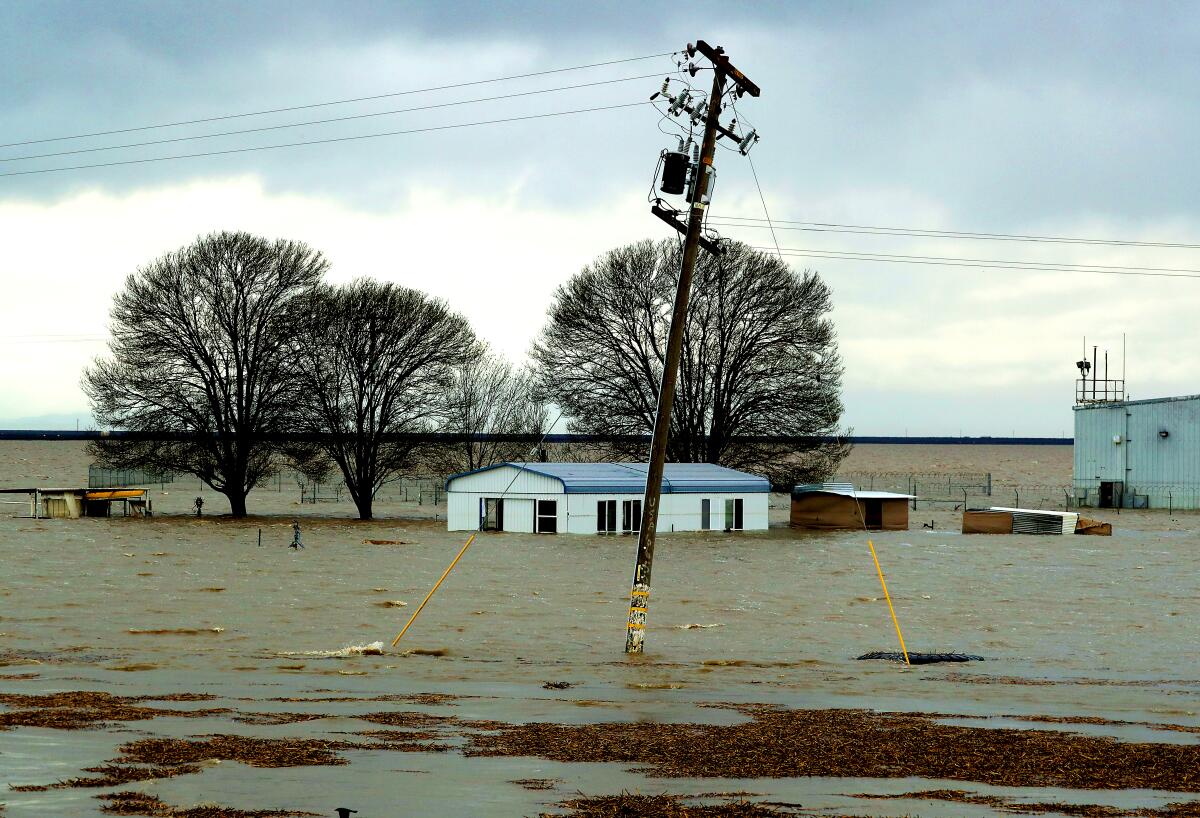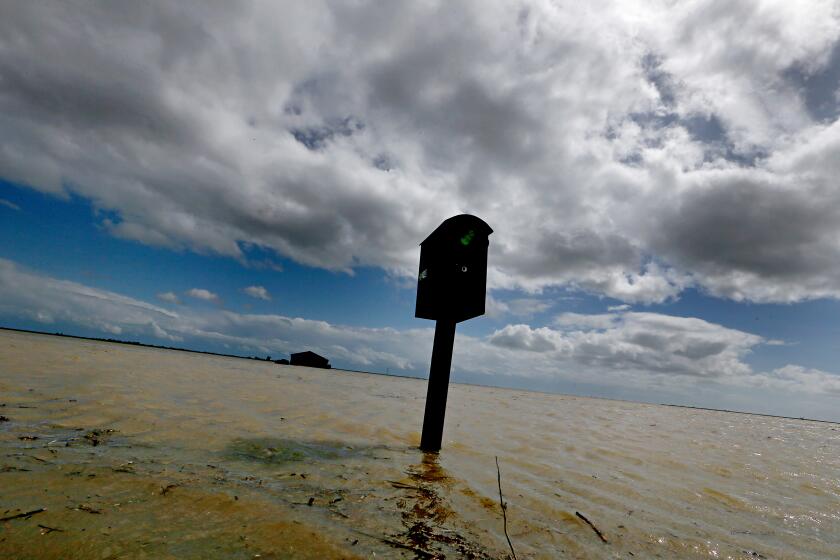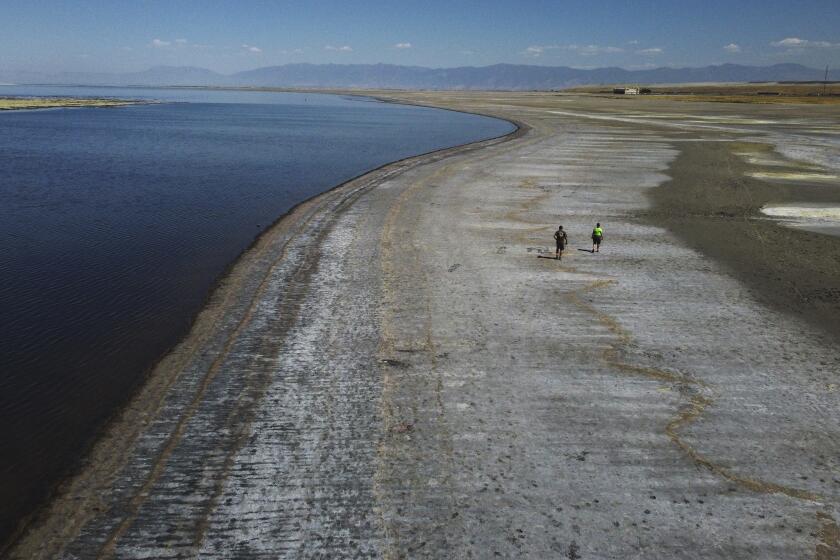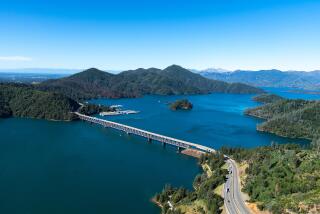Opinion: Don’t call it a comeback: California’s Tulare Lake never really went away

Only two centuries ago, a shallow inland sea dominated California’s Central Valley. In a ring of impenetrable reeds, called tules, was Tulare Lake — then the largest body of freshwater west of the Mississippi River. At the end of the 19th century, newly arrived settlers began draining it to provide water for agriculture and growing cities and to defend against destructive floods. But during wet years, as 2023 has turned out to be, Tulare Lake seems to rise from the dead — with some labeling it a “phantom lake.”
The reality is, Tulare Lake was never gone in the first place. Seasonal rains created an ebb and flow of the boundaries as the shoreline shifted. In drier years, Tulare was two lakes separated by a land bridge. In wetter years, these lakes connected and created an archipelago. In the driest years, the southern lake disappeared and the archipelago became a beach.
Rather than killing the lake, farming simply intensified this rhythm of flooding and droughts: long periods of agricultural fields punctuated by heavy floods. Tulare Lake is not a phantom, but a revenant: that which returns. Its resurgence was noted in 1997 and 1983, and now this year, but it’s a constant cycle.
As historic storms fill once-dry Tulare Lake and submerge prime California farmland, tensions are building over how to handle the swiftly rising floodwaters.
As the Algerian French philosopher Jacques Derrida wrote: “A ghost never dies; it remains always to come and to come-back.” In 1936, the last speaker of the Chunut language, Yoimut, warned historian Frank F. Latta that the lake would return — and that she wanted to see that time herself.
Yoimut had spent her childhood on an island in the lake, now the site of a small farming town called Alpaugh. Ranchers eventually forced Yoimut and her family off the island, threatening to set the dry reeds on fire. Yoimut saw Tulare Lake dry completely, mourning it until she died in 1937. She grieved to Latta: “Cotton, cotton, cotton: that is all that is left. Chunuts cannot live on cotton.”
However, Yoimut remained hopeful that the lake would return. Latta eventually thought Yoimut was vindicated: Catastrophic flooding on the lakebed throughout the 20th century proved that Tulare was not gone just yet. For its propensity to return, writer Gerald Haslam called it “the lake that will not die.”
This year, we see yet another Tulare return: The ghost lake begins to fill the ancient basin. Its usual appearance of salt scrub and cotton fields, owned chiefly by the J.G. Boswell Co., is revealed to be a temporary state. Severe storms and melting snowpacks bring more floods. Farmers rush to protect their fields while farmworkers evacuate their homes. Their goals are not always compatible, as diverting the water from one location may flood another.
Salt Lake City’s namesake is evaporating, and with it a resource crucial to the West’s economy, weather and health — not to mention millions of migratory birds.
At a special meeting of the Kings County Board of Supervisors this month, J.G. Boswell representatives argued that it was within the corporation’s rights to defend their property. This property, of course, was originally acquired via an act of violent theft by white settlers. Yoimut lived to see the Boswell corporation grow cotton on her ancestral home, where she was never able to return. Tulare Lake looms eerily in the distance amid burgeoning water crises. The southern Sierra Nevada has record snowpack, warming weather may send up to 60 inches of rain toward Tulare, and the valley is sinking from groundwater pumping.
In the Tachi creation story recorded by Katharine Berry Judson, Tulare Lake was the site of creation, from a celestial oak stump standing alone above its quiet waters. It is only hubris to believe that the very origin of creation could be kept hidden. Yoimut knew this well, looking forward to a time when she could see her home once again — underneath the cotton, the lakebed. In this valley, we reap what we sow.
Trace Fleeman Garcia is an interdisciplinary researcher with the Oregon Institute for Creative Research in Portland. His studies include the ecology and history of the Tulare Lake region.
More to Read
A cure for the common opinion
Get thought-provoking perspectives with our weekly newsletter.
You may occasionally receive promotional content from the Los Angeles Times.












